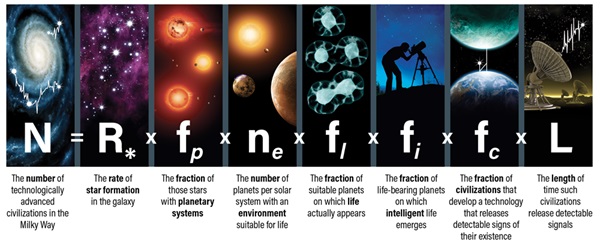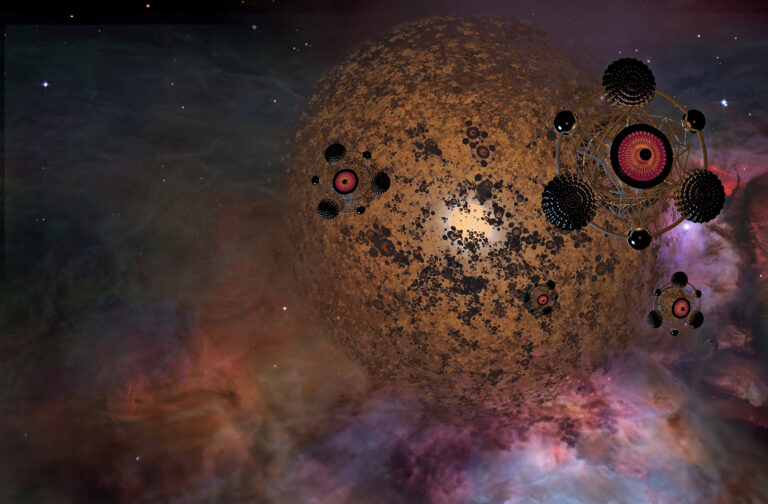Key Takeaways:
- The search for extraterrestrial life uses radio signals, telescopes, and rovers.
- The Fermi Paradox questions why we haven't detected alien civilizations.
- The Drake Equation estimates the number of potential alien civilizations.
- Promising places to search for life include Mars, Europa, and Titan.
Are we alone?
This question has plagued humankind since time immemorial. And yet, we still don’t have a conclusive answer. Despite our incredible technological advancements, we have never received a credible radio signal from, or even the teeniest trace of, extraterrestrial life beyond Earth.
The current hunt for alien life includes: the Search for Extraterrestrial Intelligence (SETI) Institute, which has scoured the skies for radio signals from intelligent beings since its founding in 1984; the Kepler space telescope, which observed more than 500,000 stars during its mission, confirming more than 2,500 exoplanets; and more recently, the James Webb Space Telescope (JWST), which just took its first direct image of an exoplanet.
Perhaps the most tantalizing potential signal from an extraterrestrial civilization is the famous Wow! Signal. This very brief, but very intense, radio signal was detected by Ohio State University’s Big Ear Radio Telescope Aug. 15, 1977, and it lasted for 1 minute and 12 seconds. The signal was so intriguing that astronomer Jerry Ehman enthusiastically wrote the word “Wow!” on the data printout.
Most now agree the Wow! Signal is unlikely to be from aliens. But in a recent May 2022 study published in the International Journal of Astrobiology, researchers identified a possible source of the Wow! Signal: a Sun-like star a bit more than 1,800 light years from Earth.
Still, the question remains: Are we alone?
“The only correct answer to this question [for now] is that we don’t know,” Manasvi Lingam, an astrobiologist and Assistant Professor in the Department of Aerospace, Physics, and Space Sciences at the Florida Institute of Technology, tells Astronomy.
“With that said,” he adds, “I am hopeful of the existence of extraterrestrial life, given the number of potentially habitable worlds and the ongoing exciting research into the origin(s) of life.”
How likely are we to find life elsewhere in the universe?
Two of the most iconic insights related to the possibility of technological civilizations existing elsewhere in the universe are the Fermi Paradox and the Drake equation, which were formulated by Enrico Fermi and Frank Drake, respectively.
The Fermi Paradox attempts to address the question “Where is everybody?” By most accounts, Fermi asked this deceptively simple question in 1950 during lunch with colleagues. The simple question has since spurred scientists to better understand the possible reasons that we haven’t heard from any technologically advanced alien civilizations.
“The Fermi Paradox is interesting because it contradicts the possibility of advanced life in our galaxy,” Harshini Sunil, an astronomy and physics undergraduate student at the University of Colorado Boulder, tells Astronomy.
“If advanced civilizations have existed before us, then they would have had ample time to develop interstellar travel and would have made it to Earth,” Sunil says. “If we invented interstellar travel, where would we go first? We have the predictions of places for life, but they are still hundreds or more light-years away. Even if we could travel at the speed of light, there is no guarantee that we will know exactly where to look. It’s like hunting for needles in a haystack. I do not think the possibility of finding advanced life is black or white. There is so much we first need to discover and learn before we can start predicting where and if advanced life exists.”
While the Fermi Paradox asks why we haven’t heard from anyone, the Drake equation attempts to spin a more optimistic approach to this conundrum. The Drake equation is an attempt to quantify the total number of technological civilizations that might currently exist in the cosmos. To do this, the equation factors in astronomical, biological, psychological, and technological elements. However, because the exact values for each of the equation’s variables are largely unknown, the Drake equation tends to estimate the number of potential technological civilizations at anywhere between one (us) and 1,000,000.
“The Drake equation serves both as a reality check and a hopeful mantra for those involved in the search for life elsewhere,” Frannie Edmonson, an astrobiology senior undergraduate student in the Department of Aerospace, Physics, and Space Sciences at the Florida Institute of Technology, tells Astronomy. “Running through its argument gives you a bleak outlook on our galaxy’s intelligent population, but the objectiveness of the equation is necessary for research. Not every stray signal we detect will be an E.T. neighbor shouting between solar systems! Still, I remain hopeful when considering the Drake equation because of our own existence; even with slim chances, our intelligent civilization exists, so there is the potential for others.”
Yet the question remains: Are we alone?
Where should we look for alien life?
For now, we have yet to confirm a definitive radio signal from ET or develop the technology needed to explore the universe beyond the solar system with a spacecraft. However, there are still a plenty of planets, and even moons, right here in our solar system that we can search for microbial life.
But where are the best places to look?
“I find it difficult to choose between sheltered places on Mars or the ocean floor of small oceanic moons like Enceladus and Europa as the ‘likeliest’ places other life could be found in our solar system,” Melissa Sedler, who recently graduated with a Masters of Natural Sciences from the School of Earth and Space Exploration at Arizona State University, tells Astronomy.
“We know from our continuing study of the Earth and its extreme environments [at least extreme from our perspective] that life thrives even where we don’t expect it,” she says. “Similar niches might be sequestered in and among the ice caps or beneath the surface of the Red Planet. But the presence of liquid water touching a rocky seafloor opens up the thrilling possibility of a place for life more as we know it. Planets, dwarf planets, and even moons can have dynamic processes at work inside them, and we’ve known since the 1970’s that Earth’s deep ocean floor allows the exchange of energy between our planet and the ocean water. Perhaps the lively oases we find at deep sea hydrothermal vents have similar counterparts beneath those extraterrestrial oceans.”
While NASA’s Curiosity and Perseverance Mars rovers are busy searching for ancient — and possibly present — signs of life within Gale Crater and Jezero Crater, respectively, NASA is hard at work on both current and future missions that will seek life elsewhere in the universe. But which of these missions could finally help us answer the longstanding question of whether or not we are alone?
“Within our solar system, I would pick the upcoming Dragonfly mission (although the missions to Mars and Europa merit mention too) because it could offer novel insights into Titan’s habitability, and perhaps uncover traces of life,” says Lingam. “The other mission I wish to highlight is the currently operational James Webb Space Telescope (JWST), which enables us to search for biosignatures and technosignatures on exoplanets.”
What would happen if humanity found extraterrestrial life?
Even if we find intelligent — or even microbial — life beyond Earth, how will this affect humanity? Would we come together as one with the discovery that we are, in fact, not alone in the universe? Or would we lose our collective minds?
“As much as the discovery of extraterrestrial life would be hugely exciting, I also can’t help but feel that it doesn’t change our place in the universe,” Ian Marrs, a PhD student in the Department of Astronomy and Planetary Science at Northern Arizona University, tells Astronomy.
“Finding extraterrestrial life would be comforting, since it would help soothe the concerns raised by the Fermi paradox. But I don’t think that it should ‘dethrone’ humanity’s place in the universe,” says Marrs. “We, like the animals and plants all around us, are the product of billions of years of evolution, and that in itself is incredible. If we find extraterrestrial life, we have enriched the story of the universe, not diminished ourselves.”
The hunt for alien life presses on
For now, SETI continues to scan the skies for radio signals, JWST keeps blowing our minds with jaw-dropping images and data, the Mars rovers keep drilling holes near their landing sites, and future missions continue to be planned to explore the outer solar system for signs of life.
And yet, still, the question remains: Are we alone?
Perhaps, one day, humanity will finally know the answer to this question. But until that day comes, all we can do is press on with our search.














